Permission has been granted for one-time use only, for the
purpose of website posting.
Courtesy of the Anchorage Daily News
No other reproductions and/or Anchorage Daily News materials are authorized.
The Alaska Federation of Natives has been given republication permission to reproduce the following Anchorage Daily News photos and articles from the Whale House Series:
Series At A Glance
Part 1: The sale of the Whale House legacy.
Part 2: Carving the masterworks.
Part 3: A Tlingit buyer of Tlingit artifacts.
Part 4: A dealer's passion for the Whale House.
Part 5: Epic sage becomes litigation.
Battle over a Birthright
Nine years ago, brilliantly carved Tlingit artifacts linking the Chilkat people with their ancestors were sold and removed from the village of Klukwan. Since then, families, neighbors and lawyers have fought bitterly over ownership. No one sees them now.
By Marilee Enge

Bill Thomas stands in front of the Whale House in Klukwan. Photo by Bob Hallinen
First of five parts
Klukwan - Bill Thomas was eating dinner when his great-uncle Clarence Hotch walked through the door of his Klukwan home one evening nearly a decade ago. Hotch's sister, Mildred Sparks, was ailing and near death. As the family's matriarch, she had a last demand of her kin.
Now Clarence had come to carry out her wishes.
"Call your brother," he said. "It's time.'"
Thomas didn't have to ask, "Time for what?" For
months the family had talked of selling the treasures of the Whale House,
great totems and a wall screen that tell the mythic tales of their people's
past.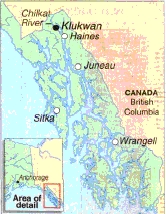
Bill Thomas was 36 and the chairman of his village corporation. He worked at an office 23 miles down the highway, in Haines, and lived in a modern home on the banks of the Chilkat River, in the heart of his ancestral village.
On that April night in 1984, Thomas called his brother and they drove their pickups to the Whale House, an unassuming concrete building that stands among some of Klukwan's oldest clan houses. Uncle Clarence rounded up two older men from the family and they all went to work.
They lowered the 9-foot tall spruce totems, wrapped them in carpet padding and carried them to the trucks. They dismantled the Rain Wall, 11-by-16-foot carved mural of the Rain Spirit, with a passageway that the chief once used to reach his private quarters.
A young villager rode by on his motorcycle and asked what was going on. He lent a hand in carrying the heavy posts from the house.
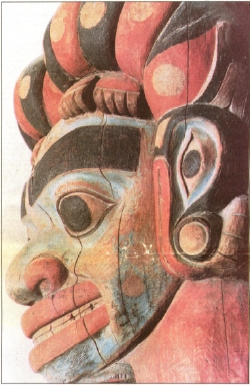
copyright © A. de Menil
The housepost carved to depict the legend of the woodworm is one of the Whale
House artifacts from Klukwan now locked by a federal judge's order in a Seattle
warehouse.
They tried to move a 14-foot feast dish carved in the shape of a woodworm, but its bottom was so rotted it threatened to crumble. They left it behind.
They drove to Haines, where Bill Thomas parked his truck at the Thunderbird Motel and showed the prize to Michael Johnson. The Seattle art dealer had worked for a decade to get these masterpieces of a Tlingit Indian carver who lived more than two centuries ago, and at last he was on the verge of realizing his dream.

“Village of Klukwan” dated
4/4/93. Photo by Bob Hallinen
The village of Klukwan in the winter of 1992-93.
Removal of the Whale House artifacts caused deep divisions that linger.
STARTING PRICE: $1 MILLION
A week later, an Alaska state ferry delivered van carrying the artifacts to Seattle, and Johnson began looking for a buyer. The starting price would be $1 million.
But Johnson's satisfaction was short lived. When Klukwan villagers learned that the great art of the Whale House was gone, they halted the sale, claiming the artifacts belonged to the entire clan and that Hotch had no right to sell them. Their decade-long fight to bring the artifacts back to Klukwan has pitted relatives and neighbors against one another, challenged the very identity of a powerful family, and grown into a monstrous legal wrangle that is not yet over.
Today, the masterpieces remain locked in a Seattle warehouse, hidden away under orders of a federal judge. Even the location of the warehouse is a closely held secret.
"It's a little bit like Indiana Jones," a frustrated Johnson said during a recent interview. "The art goes into the government warehouse and it's really safe, which means it will never be seen. It'll be lost in the bureaucracy. It's the "Ark of the Tlingit.'"
The intrigue did not begin that evening in 1984, or even with Michael Johnson's first offers in the 1970s. It started a century ago, when the first outsiders saw the Whale House and discovered its monumental carvings.
Nearly 200 years ago, the totems and screen are regarded as the pinnacle of the golden age of Northwest Coast Indian art, a time when carvings flourished with the introduction of metal tools.
Collectors and museums prized the Whale House artifacts for their unparalleled artistry. But the people of Klukwan valued them for what they symbolize. The objects to legends belonging to the village's earliest residents and represent the glory of its most powerful clan.
Today, as Native people struggle to hold on to their endangered culture, villagers say the art is more important to them than ever.
In January, an unprecedented tribal court convened in Klukwan to hear the case of the Whale House artifacts. A judge was asked to decide questions of traditional Tlingit law, family lineage and, ultimately, the village's powers to prohibit such sales. The factions found themselves carrying on the fights of relatives long since passed away, honoring the irreconcilable dying words of uncles, aunts and grandparents.
Some facts seemed straightforward. In reaction to persistent dealers like Michael Johnson, the village passed a law in 1976 forbidding anyone from removing old clan art from Klukwan. Village leaders, joining a growing movement of aboriginal groups throughout the world, sought an end to a century of plundering by distant museums and art dealers.
In recent years, the ethics of curators have fallen more into line with the demands of tribes. But there are still respected voices in the art world who advocate the right to buy and sell cultural artifacts and to display them where they can be seen by the most people.
The two positions played themselves out in Seattle last year, after a local artist gave a lecture on the Whale House carvings at the University of Washington. The speaker's position was plain: the objects had been rescued from the village and now belonged in a major American museum.
After the talk, a Tlingit man who identified himself only as coming from Klukwan, stood up to object.
"I was beaten for speaking my language. Even that was taken from us. It's enough of the taking," he said.
"It's all fine and dandy for 100 people to sit here and appreciate the ownership of a piece of art," he said. "To me, there was enough taken from us."
WHOSE ARE THEY?
Hundreds of important artifacts were sold from Klukwan before the Whale House pieces took the ferry south: ceremonial hats and staffs, boxes and bowls, baskets and Chilkat blankets woven of spruce bark and goat's wool and dyed with forest mosses. Art of the northern Tlingit Indians is on display in museums around the world. But the Whale House pieces were more famous, more exquisite, more important and more valuable than any other artifacts from the village.
Klukwan is the only remaining village of Chilkat Indians, once the richest and most powerful of some 17 Tlingit tribes. The Tlingits, who were more affluent than other Alaska Natives, ranged from the southeast tip of the Panhandle north to Yakutat on the Gulf of Alaska.
The Chilkat derived their wealth and influence from their location. Situated on the Chilkat River, on the Alaska mainland, they had access to the sea and Interior. They controlled trade routes between the southern Tlingits and northern Athabascans. They are regarded as the most traditional and conservative of the Tlingits, a warlike seagoing Indian nation more closely related to other tribes of the Pacific Northwest than of the Alaska Interior.
A series of a classic black-and-white photographs from the turn of the century lent renown and mystique to the art of the Whale House. Respected ethnographers and art historians published volumes on the subject. One, the Navy officer them by the name of Lt. George Emmons, in 1916 called the Rain Wall screen "the finest example of native art, either Tlingit or Tsimshian, in Alaska."
"I personally think the screen and the four posts...is the singular most extraordinary artwork in all the Northwest Coast," said Aldona Jonaitis, an art historian and expert on Tlingit art. "They are so beautiful, so well-documented, so masterfully carved, exquisitely painted. There's an elegance and a refinement that's breathtaking."
But whose are they?
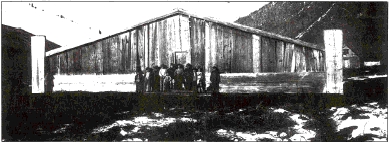
Photo by Winter and Pond
Children pose in front of the Whale House in Klukwan in this 1895 photo.
A family known in court papers as the Whale House group argues that it is the rightful owner. The group is a modern Tlingit family that includes a hairdresser, an artist, fishermen, school teachers and village corporation officials. They hold the key to the padlock on the Whale House, a function that usually signifies leadership in Tlingit society.
As the descendants of the last two house caretakers, they insist that they were born into the Whale House. They have maintained since 1984 that they had the right and the duty to sell the art treasures because their leader, uncle Clarence Hotch, ordered them removed.
"I'm the chief," Hotch said in a 1985 deposition, three years before his death. "Anything I say goes."
To begin to understand the inheritance question requires some knowledge of Tlingit social organization. Individuals within families are grouped into "houses." Birthright runs through the mother's line. If your mother was born into the Whale House, you would be too.
Leadership of a house follows a similar path, from the maternal uncle to nephew. If your mother's brother was leader of the Land Otter House, you were in line for a leadership role in that house, too.
The Whale House Group are descendants of Mildred Hotch Sparks. Mildred's brother, Victor Hotch, was caretaker, or hitsaati, of the Whale House for 40 years. In the last decade of his life he was torn between a brother and sister who wanted to sell the artifacts, and a son, Joe, a leader in the movement to block the sale.
Victor's wife was of the Bear House, so their son Joe was an heir to the Bear House, not the Whale House.
THE 'UNCLE SYSTEM'
When Victor died in 1981, leadership of the Whale House passed to his brother Clarence, who was among those who wanted to sell the carvings. The uncle's word was good enough for Bill Thomas, who helped Clarence Hotch remove the artifacts in 1984.
Then, when the case with to trial this year, Thomas, 45, had the task of defending his uncle.
"We were raised under an uncle system that was very strict," Thomas said in his opening statement. "We did what the uncles told us."
"This is a man I dearly loved," he said. "I will do everything I can through this whole process to defend his honor and the great honor with which we buried this fellow."
At times, the trial seemed like a fight over whose version of family history, social responsibility and Tlingit culture would stand, or, even more simply, which uncle's commands would be followed by his survivors. Both sides claim to be the real caretakers of tradition.
Thomas and his family say that taking away the artifacts was an effort to preserve them, not just to profit, though the sums involved were huge: they stood to gain more than $1 million from the sale.
The art world has mostly state out of the fray, hoping the pieces will eventually be displayed somewhere.
"These are very important artworks," said Jonaitis, a curator at the American Museum of Natural History in New York. "They're treasures of the Chilkat. They're treasures of the Tlingit. They're treasures of Native Alaskans. They're treasures of the world."
And the world has spent at least a century trying to make these treasures its own. Nearly all the notable Northwest Coast collectors bid for the Whale House objects. Museums and dealers have bargained and pleaded, needled and almost robbed the keepers of the Whale House to win this Tlingit Holy Grail.
Two men in particular made the acquisition of the masterpieces their life's quest - art dealer Michael Johnson and Louis Shotridge, a Tlingit from Klukwan who worked for a Philadelphia museum in the early part of this century.

“
Door of Whale House” dated
4/4/93. Photo by Bob Hallinen
The front door of the Whale House: The story
of the struggle for its treasure began a century ago, when outsiders first
saw the house and the monumental carvings it held.
A WOODWORM AND A VILLAGE DIVIDED
The art and the struggle to acquire it have been likened to the Elgin Marbles. The marble friezes from the Parthenon in Athens were the greatest treasures of classical Greek art. Lord Elgin, Britain's ambassador to Greece, removed them and took them to England, perhaps under false pretenses. England now considers the carvings part of its own national heritage, but the Greeks say they were stolen and should be returned.
The Whale House carvings stand as brilliant art, and as ethnographic signposts that reveal mysteries of the people who created and used them in their most important ceremonies. They are the history books of a great culture with no written language.
"As a scholar and a museum person, it would be terrific to see these things on display," said Jonaitis. "But as someone who's very interested in Native causes, that may not be appropriate now or at any time."
Klukwan today is a ramshackle village of about 120 year-round residents. It sits just off to Haines Highway, about 20 miles upriver of the port town of Haines.
Klukwan gained title to some of the best timber land in Southeast Alaska from that Alaska Native Claim Settlement Act. Klukwan Inc.'s successful logging operation provides jobs to shareholders, and, in 1991, each received a $30,000 share in the profits.
Villagers lived in western-style homes with their western-style nuclear families. But the clan houses are there, reminding them of who they are and where they come from.
A row of old clan houses stands along the upper side of Klukwan's main street, facing the river. Some are fanciful, with Victorian gingerbread and bay windows. But they are nearly all in disrepair; a few look as if they would blow down in a good wind. These houses represent not only the village's former prestige but also its present-day decline.
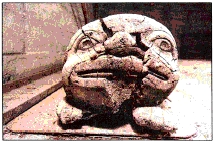
The face on the Woodwrom Feast Dish in the Whale House.
Clan houses were part community hall, part manor - a ceremonial chamber and residence for the extended family of the chief. Members prepared their crafts and food there, stored their ancestral icons inside, and held great potlatches with neighboring clans.
The present-day Whale House was built in 1938, of poured concrete to protect its treasures from the fires and mudslides that have devastated many other houses and their artifacts. It's mostly empty today. There is an antique woodstove, an old wringer washer and a portable phonograph, some straight-back chairs and long tables.
All that's left of the crest art that identified the once-powerful family and told its history is the rotting woodworm feast dish. During the great potlatches of the past, it held Native delicacies. It is probably older than the totems and the screen; when Lt. George Emmons first saw it in 1885, the dish had already decayed beyond usefulness.
The story of the woodworm tells how the Ganaxteidi clan, which includes the members of the Whale House, came north to the Chilkat region from Prince of Wales Island. The myth is also portrayed on one of the house posts.
A chief's daughter found the worm in a woodpile and kept it as a pet, secretly feeding it until it grew very large. She loved it and sang a little song that still is sung by Tlingit mothers. But when her family discovered the worm, they reacted with dread. Her uncle called a meeting, and the people decided the woodworm must be destroyed before it killed everyone in the village. While the girl was lured from home, the village men brought their sharp wooden spears against the worm, and killed it. The chief's daughter was devastated. The event so divided the village that her family, the Ganaxteidi clan, left and migrated north.
Today, the Ganaxteidi people are once again divided, this time by the carvings created nearly two centuries ago to depict their history and to bring them together.
The Whale House of the Chilkat
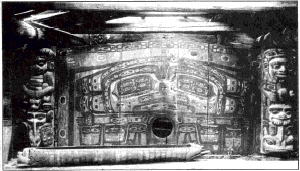
Rain Wall "Seew X'eenh"
At one end of the house, between the two house posts, an 11-foot-high by
16-foot-wide wall of red cedar planks encloses the private dwelling of the
chief clan spokesman and his family. The entire front surface of this wall
is painted and carved in low relief. This wall is an important crest symbol
for the Ganaxteidi clan, representing its close ties with Raven. The Raven's
arms or wings are outstretched; his body is opened to allow entrance to the
room behind. Around the sides, a crouching figure is repeated to represent
the character of raindrops. The raindrop figures are called Seew-con nutchee, "Raindrops
splash up." According to Martha Willard, and elder of the Klukwan Ganaxteidi,
the raindrops show that Raven's actions and presence in the world are feft
by all: "Just as the rain falls on all things alike, so too are the
effects of Raven's adventures felt by all the world."
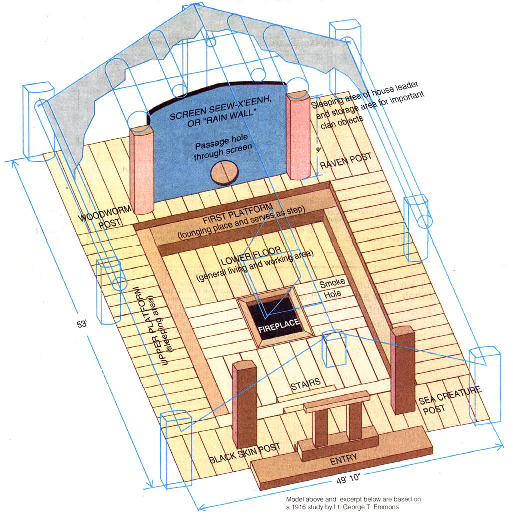
The carved post to the left of the Rain Screen tells the story of how the Ganaxteidi clan came to move north up Lynn Canal. copyright © A. de Menil |
Tells the story of T'a,the King Salmon. The main Raven figure is in human form. copyright © A. de Menil |
Tells the story of the famous Tlingit hero Dukt'ootl, or Black Skin, which is shown tearing a sea lion in two. copyright © A. de Menil |
Represents an episode from the adventures of Raven and the sea creature Gunakadeit. copyright © A. de Menil |
The Old Whale House
"
When I first visted Kluckwan in 1885, the old communal houses of the Kon-nuh-ta-di
(Ganaxteidi) a were still standing, the principal one of which, that of the
hereditary chief, Youhg-it, "Whale house" was in the last stages
of decay and was on uninhabitable, although the interior fittings were intact
and it was still used upon festival occasions. It was unquestionably the
most widely known and elaborately ornamented house, not only at Chilkat,
but in Alaska. It is said to have been built by Kate-tsu about or prior to
1835 and stood in the middle of the village. The village lies at the edge
of a gradual slope on the north bank of the Chilkat River, 20 miles from
its mouth, where the swift current concentrated in a single channel forms
a strong eddy that permits the landing of canoes at any stage of the river.
The houses in the single and double row follow the trend of the short for
upwards of three quarters of a mile, but far enough back to allow for smoke
houses, fish drying frames and canoe shelters, and in the rear are the grave
houses."
Lt. George T. Emmons
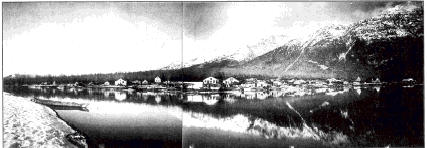 Klukwan Village
Klukwan Village
The photographs to the left, a composite of two photographs probably taken
in the spring of 1895, shows the Tlingit village of Klukwan on the Chilkat
River, some thirty miles from the Lynn Canal in the northern part of the
Alaska panhandle. It depicts a village in the midst of change. Houses are
still in the traditional style of the communal longhouse, facing out toward
the water. Some are made with rough boards, tack windows and have open
doorways. Others are painted, appear to have been built from milled boards
and have windows and hinged doors. Most of the houses with windows for
large and were probably owned by high-ranking families that were wealthy
enough to make renovations.
 Clarence Hotch |
 Joe Hotch |
 Michael Johnson |
 Mildred Sparks |
WHO'S WHO IN PART 1
CLARENCE HOTCH: Whale House caretaker who ordered the carvings removed.
VICTOR HOTCH: Brother of Clarence and Mildred Hotch, lead Whale House for 40 years.
JOE HOTCH: Victor's son; born into the Bear House; village council president.
MICHAEL JOHNSON: Seattle art dealer who planned to consign the artifacts to a buyer.
ALDONA JONAITIS: Curator of Northwest Coast art at the American Museum of Natural History; expert on Tlingit art.
MILDRED SPARKS: Clarence's sister and Bill's grandmother, urged her kin to sell the art.
BILL THOMAS: 36-year-old chairman of Klukwan, Inc. in 1984, helped his uncle move the artifacts from the Whale House.
 Woodworm Post
Woodworm Post Raven Post
Raven Post Black Skin Post
Black Skin Post Sea Creature Post
Sea Creature Post